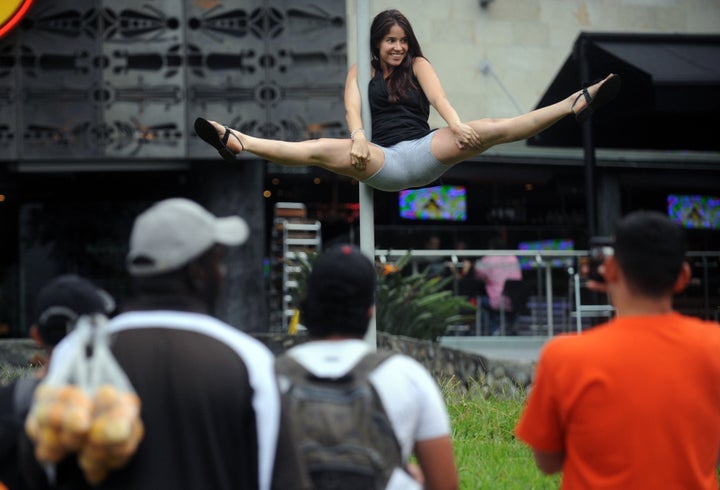
Now that pole dancing has moved out of strip clubs and into gyms, it seems only natural that it would end up in the streets.
That's what happened recently in Medellin, Colombia, when some of the South American country's most accomplished dancers took the street to promote the activity by swinging, twirling and climbing up every street sign and scaffold available.
The mass pole dance featured students and instructors based in Medellin. It was designed to promote pole dancing in Colombia as well as Miss Pole Dance Medellin, an event taking place July 2, and "Miss Pole Dance Colombia," an event taking place July 30.
Organizer Alejandra Santamaria said the street-smart campaign is crucial to getting her fellow Colombians to recognize pole dancing as a great form of fitness.
"We wanted to promote what pole dance can be: a great deal of gymnastics, lots of technique and fun," she told AOL Weird News. "Pole dance has still lots of space to grow. As of today, it is not even understood. In Latin America, many still think it is related to striptease and they have no clue about the challenge it represents."
But as difficult as pole dancing can be in a gym or on a stage with a shiny brass pole, the techniques are even more difficult when practiced on wooden stakes or metal street signs, according to Ingrid Tsai, Santamaria's partner in pole dance promotion.
"The hardest part in urban pole dancing is finding a structure with a good caliber," Tsai said. "Usually, dancing poles have a diameter of 1.75 to two inches. Apart from the caliber, the material in street structures can make the job harder. Dancing poles are made from stainless steel or brass, which facilitates the friction you need to have between your skin and the surface."
"So, it may appear to be easy, but urban pole dancing can be much harder that what people think," she said.
According to Wendy Traskos, the founder of the United States Pole Dance Federation, which is working to make pole dancing a recognized sport similar to ice skating, "street pole" is a spontaneous activity usually practiced by students after they have built up strength in their upper bodies.
"Their bodies are changing and they are getting addicted to climbing and swinging," she said. "It feels like you're going back to your younger days playing on the monkey bars. You'll see people flipping themselves off of street signs or climbing scaffolding."
Traskos understands the enthusiasm, but warns that "street pole" is something that shouldn't be attempted without serious training.
"You have to walk before you run," she said. "You learn to do a somersault on the ground before you do it in the air. The problem is -- and what we're trying to do -- is establish a structure on training. There is some bad instruction out there. You don't want to see a woman who is 30 pounds overweight trying to lift their hips over their head on their third day of lessons."
Traskos, who offers classes to pole dancing teachers, says the key thing that street pole dancers need to remember is to check out the pole or scaffold before attempting the trick, because the texture can make a difference.
"These moves are even more physical than the ones in classes," she said.
And that's part of the appeal according to Kelly Blake, a pole dancing instructor in Sarasota, Fla. who once "street poled" on the airport terminal shuttle at Charles DeGaulle Airport in France.
"It's a natural part of pole dancing," she admitted. "Soon as you start to get that strong, it's hard not to use it."
Blake recommends "street polers" use gloves when attempting their stunts outside of clubs or gyms, and she says never drink beforehand.
Although "street pole" is different from traditional pole dancing, Blake sees it as being a good way to take away the strip bar stigma.
"It's fun to do it at a busy intersection and get people to look at you and they don't look at you trashy," she said.
But "Charley" Crystal Harris, a pole dance instructor in Pontiac, Mich., warns would-be "street polers" that they could get some strange looks.
"It can go both ways," she said. "Some people will give you funny looks and assume we're strippers who just don't have a pole. But, really, we're just doing tricks. It's not like we're bringing music to the park."
"On the other hand," she said, "little kids think it's cool. They don't know about strip clubs and just think I'm, like, doing a handstand across the park."
Although "street pole" is still an underground activity, Julia Kurz, a pole dance instructor in Boston, says Beantown seems to be a hot spot for it.
"I've seen a rash of sightings on Boyleston Street around 2 a.m.," she said. "After some girls have had a drink, they will show off their skills by doing them on scaffolding. However, it's hard to twirl around on stop signs because the poles are square."
As for Kurz, she is most likely to "street pole" on sunny days, but she says it's best to take precautions before doing any "street poling."
"You can do it while wearing high heels, but I do suggest wearing gloves and pants," she said.
Blake believes that New York City is the best place for "street poling."
"You can't walk 10 feet without running into a brass pole," she said wistfully.
Tsai believes the recent street pole campaign did a lot to raise awareness about pole dancing, but she admits she isn't sure if the street version will ever replace the indoor version.
"A dancing pole will never be replaced with a red light!" she laughed. "It is hard to say that 'urban pole' will be the future of pole dancing. However, pole dancing will become more common and more women will start joining this discipline so, maybe, with time, we will probably find more and more people climbing and spinning around our streets!"

